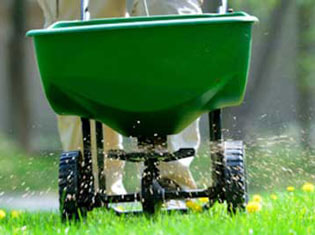Many people come out of winter, seeing their lawns that have become thin, discolored and overall unhealthy or sparse from the winter months, especially in a season where we’ve had so much rain. Flooding and excess moisture from long periods of rain can drown out roots, causing die back. As well as damage from excess shade from the low sun during the winter and frost damage from cold winter nights.
So when is the best times to be seeding to bring back or improve your lawns?
Springtime Seeding
Seeding lawns in the springtime can be beneficial, but it’s important to consider the specific conditions of your lawn and climate before deciding when to seed. Here are some benefits and downsides to seeding lawns in the early spring:
Benefits:
-Temperatures are typically moderate in the spring, which can be ideal for seed germination.
-Spring rains can help provide consistent moisture for the new grass to grow (seed needs to stay moist all day long, everyday, for up to 3 weeks to germinate properly).
-Seeding in the spring allows the grass to establish and grow throughout the summer (assuming that the new growth survives the summer), possibly leading to a healthier lawn overall.
Downsides:
-The risk of late spring frosts can damage or kill young seedlings.
-Spring seeding may not be successful if soil temperatures are not consistently above 50°F (10°C).
-The warm and moist conditions of spring into summer can also create favorable conditions for disease to develop in new seedlings.
-Seeding in the spring can sometimes require more watering, as the soil can dry out quickly due to increased temperatures here in California.
-Early temperatures rising above 90 degrees into Summer can quickly kill off new growth that has not been established long enough.
Fall Lawn Overseeding
Seeding lawns in the fall is generally considered the best time for successful germination and establishment of new grass. Here are a few reasons why:
-Optimal soil and weather conditions: Fall typically brings cooler temperatures and increased rainfall, creating ideal conditions for seed germination and establishment. In addition, soil temperatures in the fall are often still warm enough to encourage root growth and development.
-Fewer weed problems: Weeds typically go dormant in the fall, making it easier for new grass to establish without competition. This can lead to a fuller and healthier lawn in the long term.
-Less watering moving into winter: Cooler temperatures and possible increased rainfall in the fall means you’ll need to water your lawn less often. This can save you time, money, and resources compared to watering during the hot summer months.
-Longer growing season: Seeding in the fall allows new grass to establish before winter, leading to a head start on growth in the spring. This can help your lawn better withstand summer heat and stress.
Overall, if you have large areas that need help or full lawn overseeding, then we suggest that seeding your lawn in the fall provides the best conditions for successful germination and establishment, leading to a healthier and fuller lawn in the long run. Aerating your lawns at least once a year and preferably with a full overseeding, is also highly recommended.
If you have small areas/bare spots that just need a little fill in, then Springtime may be ok to do these types of seeding.
-Ultimately, the best time to seed your lawn will depend on factors such as your location, climate, and specific lawn conditions. It may be helpful to consult with a lawn care professional to determine the best time to seed for your specific situation.


